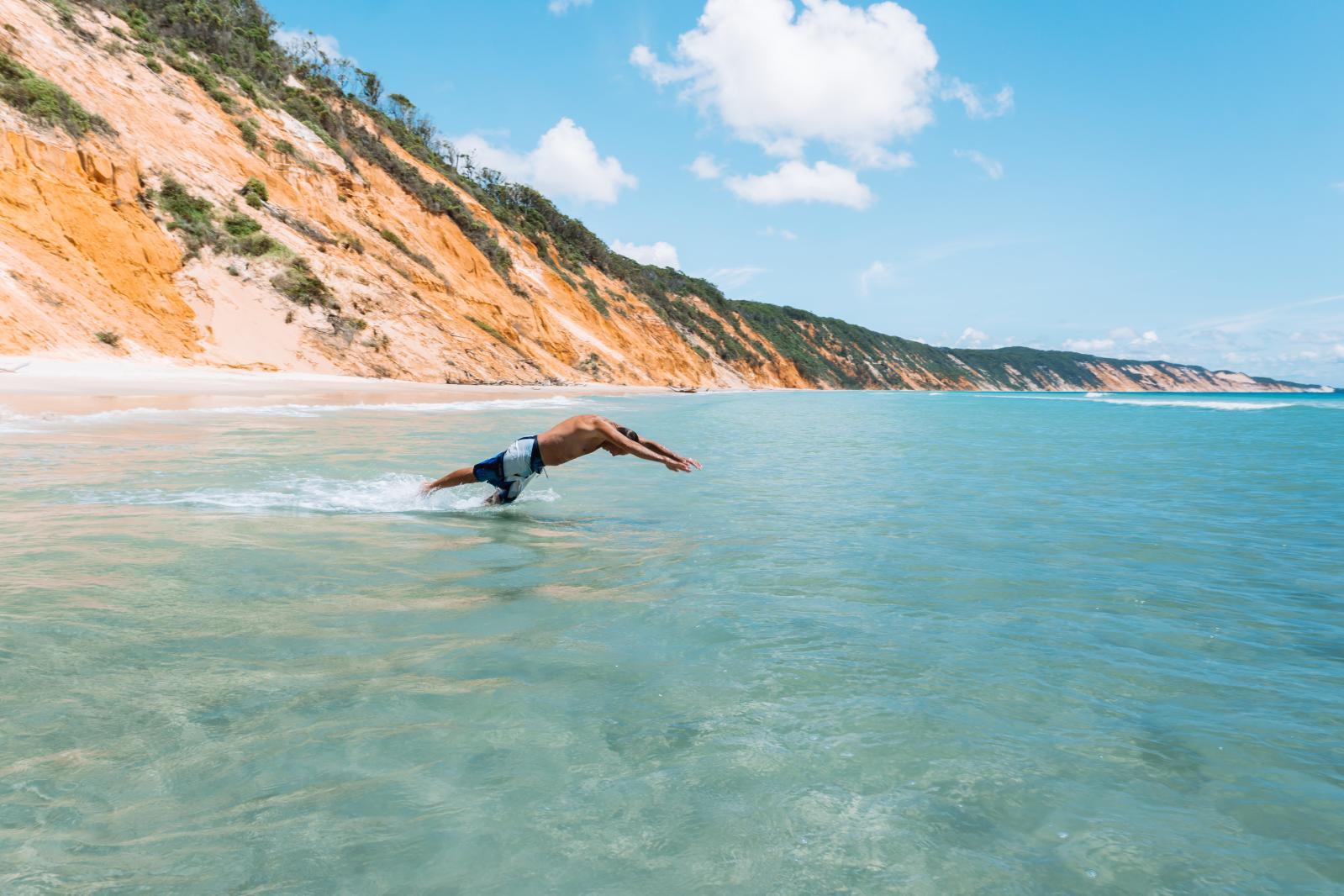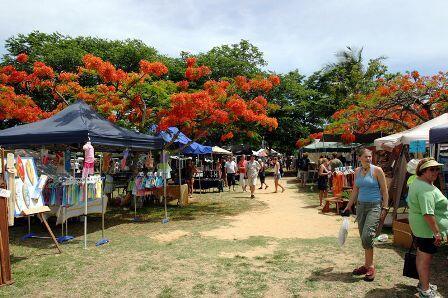Noosa Nearby Regions Holidays & Travel Guide

Cooloola Coast
Situated in Queensland's south-east corner between Fraser Island and Noosa, the Cooloola Region is a wonderful blend of beaches, waterways, rural hinterland, and heritage. The region consists of the coastal towns of Rainbow Beach and Tin Can Bay, the heritage city of Gympie, and the rolling hills of the Mary Valley, offering several unique holiday destinations within one location.
The Cooloola Region provides a natural getaway - the only 'highrises' are the Coloured Sand cliffs and the mountains of the State Forests.
For some adventurers, getting back to nature means sailing on the protected waters of Tin Can Bay and meandering up the Sandy Straits. For others, it's soaking up the sun and sea breezes during a walk along the beach at Rainbow Beach, with Double Island Point and the Coloured Sands in the background painting the perfect picture.
For those who like something less strenuous, there is a always picnicking on Lake Borumba in the picturesque Mary Valley, or a stroll through the bush walks in the State Forests. Another relaxing outing is a train journey on the 'Valley Rattler', a chance to relive the time when steam train travel was the order of the day. It makes the historic 40km journey from Gympie through the Mary Valley, visiting the towns of Dagun, Amamoor and Kandanga, then stopping in Imbil before the return journey to Gympie.
Gympie
Gympie is the heritage and cultural centre of the Cooloola Region, with a population of around 36,000 people. Known as the 'Town that Saved Queensland', Gympie's proud heritage began in 1867 with the discovery of gold by prospector James Nash at the site now occupied by the Town Hall.
At the time, Queensland was facing bankruptcy due to drought and the fall in wool prices. However, Nash made the five day journey down the Mary River from Maryborough and, after digging up 75 ounces of gold in six days, staked his claim. The Gympie Gold Rush began, injecting the boost to the Queensland economy that enabled the colony to survive.
Today, you can relive the tradition that has given Gympie its special place in history. At the Gold Mining Museum, displays covering the gold rush days are mingled with exhibits such as the Lighthorse Museum and Andrew Fisher House. Other attractions such as the Mary Valley Heritage Railway and Woodworks Forestry and Timber Museum provide memorable links to the region's railway and timber history.
The city's heart is Mary Street, a blend of shopping, heritage and nearby parkland. Take a heritage walk past traditional shopfronts as well as well-preserved examples of nineteenth-century architecture.
Gympie's location, right on the Bruce Highway about a 2 hour drive north of Brisbane and 40 minutes north of Noosa, makes it easily accessible for travellers looking for a special slice of Queensland. It's also centrally located to the breathtaking coastline of Rainbow Beach, the dolphins of Tin Can Bay, and the rural hinterland of the Mary Valley.
Mary Valley
In the Mary Valley, you're never too far away from a country town and country hospitality. The Mary Valley Scenic Way is the main route linking the towns of the Valley, with several 'back roads' providing picturesque alternatives.
This area is a patchwork of pineapple plantations, grazing properties and macadamia farms. Pineapples are the major crop grown here, with the entire area providing an outstanding hinterland experience characteristic of rural Australia.
The best way to access the Mary Valley is north from Gympie, with the southern approach through Kenilworth and the Blackall Range.
Mary Valley Highlights
- Lake Borumba: 11km from the township of Imbil, the lake is popular for water skiing and recreational boating. Camping is permitted in the adjacent camping area.
- Imbil Forest Drive: Take advantage of this 14km scenic drive through Imbil State Forest. The drive takes about an hour, with information stops, a short walk and a beautiful lookout with views of the surrounding countryside.
- Bellbird Habitat: This site has been set aside as a special management area for the protection of the colony. Listen for their bell-like calls as you look for these olive-green birds in their natural environment.
- Imbil Markets: The markets are open each Sunday from 9am - 2pm to coincide with the Valley Rattler Train.
- Amamoor Creek State Forest Park: Nestled along the banks of Amamoor Creek, this park provides an open grassy camping area in a forest dominated by ironbarks and blue gums.
- Cedar Grove State Forest Park: This park is situated in a rainforest area noted for its red cedar trees. Amamoor Creek flows around the park, providing campers with cool, fresh water for swimming, while the rainforest walk gives the bushwalker a taste of sub-tropical rainforest.
- Amama Forest Recreation: This is an ideal place for picnicking. A nearby rainforest walk has been established and the range of ferns, vines, palms and rainforest trees along the way combine to make the walk a rewarding experience.
- National Country Music Muster: The natural bush setting provides one of the most spectacular entertainment venues in Australia, as thousands of people head for Amamoor Creek State Forest Park to attend the annual National Country Music Muster over the last weekend of August each year.
Rainbow Beach
Rainbow Beach is the perfect place for a getaway with rolling surf and kilometres of unspoilt, white sandy beaches. This former sandmining town is often known as the 'Gateway to Fraser Island', but this town of around 900 people has so many attractions that it's an eco-tourism destination in its own right.
The Cooloola Section of the Great Sandy National Park invites you into a four-wheel drive wonderland of rainforest, freshwater lakes and deserted beaches. Visit the outstanding attractions such as the Coloured Sands, Carlo Sand Blow, Double Island Point, Inskip Point and the Cherry Venture Shipwreck. The park is full of bush-walking tracks, picnic facilities and offers the only beach camping facilities between Fraser Island and Noosa.
Boating is a popular pursuit from Rainbow Beach, as Carlo Point offers access to the protected waterways of Tin Can Bay Inlet. From here, recreational boats can put into the Inlet and open up a host of fishing and watersports options. And, of course, fishing from the beach remains one of the primary activities of visitors and locals alike.
Rainbow Beach highlights
- Lake Poona: Take a few sausages for a barbeque and after lunch walk through the rainforests for a swim in Lake Poona. Please check the road conditions from the Queensland Parks and Wildlife Service beforehand as road conditions may vary.
- Coloured Sands: Just a short drive from the freshwater camping area, this magnificent natural structure is worth the drive. It is vital to check the tides before four-wheel driving along the beach.
- Cherry Venture Shipwreck: This former cargo ship was swept onto Teewah Beach during cyclone conditions in July 1973. After four years of frustration trying to free the ship, its owners abandoned it to its current role of posing for curious on-lookers.
- Four Wheel Driving: A number of tours to the Cooloola Section of the Great Sandy National Park and Fraser Island operate out of Rainbow Beach. A commentary provides background information on these truly spectacular natural attractions. For independent travellers, maps and information is available from the Cooloola Region Visitor's Information Centre.
- Double Island Point Lighthouse: This spectacular lookout offers breathtaking views of the coastline in either direction. Dolphins and other wildlife have been spotted and, during the migration season, whales have often been sighted off the point.
- Carlo Sand Blow: The Carlo Sandblow at Rainbow Beach is a popular launching pad for hanglider enthusiasts, with a walking track to the Sandblow from Cooloola Drive.

Cottage Towns
Inland from Noosa are the old cottage towns of Cooroy, Eumundi (famous for its markets), Yandina, Cooran, Kin Kin with its rolling hills and old country pub, and Pomona, where every July man is pitted against Mt Cooroora for the annual King of the Mountain Festival.
Boreen Point
Situated on Lake Cootharaba, Boreen Point is a pretty waterfront township popular for its lake views and as a launch point for all manner of boating and water sports. Visitors can hire sailing boats, windsurfers and canoes from the banks of the lake.
The town's Apollonian Hotel is known among locals in the Noosa area for its hearty food and country atmosphere, while the restaurant which overlooks the lake, The Jetty, has long attracted diners from far and wide for its cuisine and long, leisurely lunches.
Eumundi
Eumundi is about 15 minutes drive from Noosa Heads and is best known for its weekly markets, which attracts crowds from far away eager to snare a bargain or buy some delicious locally made and grown produce.
On market days, each Wednesday and Saturday morning, the normally sleepy town comes alive with stalls and entertainment.
